Artist Interview, Ian Hayden(part2 English)
2016.11.02
I conducted an interview with Ian Hayden, who has been living in Japan for over 30 years and is currently working as a wood turning artist. I visited his workshop in Nikko, Tochigi.
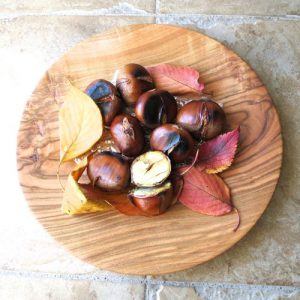
○Please tell me what made you decide to become a professional wood turning artist?
→I started by making small items out of wood works as my hobby, and then bought a wood turning lathe and starting being a bit more creative. After seeing my work, my friends asked me to join their tent at the Mashiko Pottery Fair a few years ago, which got me started to think about becoming a professional.
○What was the reaction to your work at Pottery Fair?
→It was really good opportunity to hear impressions from customers directly, and I think this was one of the turning points that made me decide to be a professional. You could find small boxes or other woodworks at the Pottery Fair about six years ago, but wood turning was rare. People picked up my work, feeling the surfaces with their hands, and touched said, “it feels really good”. From the various comments and conversations I had, I realized then that people love both the touch of wood and its natural warmth.
In fact I had an unforgettable experience at the Pottery Fair. A lady who was the first purchaser of my work said, “This is my treasure,” and she was holding a wooden salad bowl I had made. I was so moved to know that my work could give someone so much happiness. This was an immeasurable sense of accomplishment. There are things that you can’t buy with money.
○Why did you want to work as a woodturner in Japan?
→Japan is my home. I have been living in Japan over 30 years with my wife.
Many foreigners – often on transfer through their companies – live in Japan for just four or five years, but they soon return home when their contract is over, or sometimes for the education of their children. But we both love this country and both have been working in Japan. We feel there is no reason to leave. Living in Japan is something natural for us.
Also, I think there is market potential for wood crafts in Japan. Although pottery is more popular, wooden products are unique and there are different business opportunities from those for pottery. There is also lots of good quality wood in Japan.
○Please tell me about your workshops. You have workshops in Nikko and Tokyo. What do you do in each place?
→I purchase most wood from either Yamagata or Tochigi. I keep this wood in Nikko and cut them down to appropriate sizes and take them back to Tokyo. I imagine what I should make from the piece of wood before I cut each piece.
My wife is working in Tokyo on the weekdays, so I also work at my workshop in Tokyo. And we spend time together in Nikko on the weekend.
○Can you explain the key features of your work?
→I try to make pieces that are as simple and natural as possible. I also want to show the beautiful wood grain of each piece. I think these are the key features of my work.
I think my duty is to expose the beauty from each block wood and “change” it into a wood turning product that can be used in people’s daily life. Pottery is a little different. I think of potters as “adding” work. They work the clay, making it into a shape, and add some glaze – some sort of design – on the surface by hand. In a way, woodturning is the opposite. I cut and shave the wood, and change it into a plate. I am trying not to take away too much from the natural beauty of the wood, in order to emphasize the beauty of the wood grain, its texture, and its shades of color.
○One of the obvious merits or your work as an artist is that you have both a Japanese sense, and at the same time, that of a foreigner. Actually, your wooden plates go well with Japanese pottery.
→I have been told by a customer that she likes the Japanese sense in my work. Of course, I am not a Japanese and I don’t have a native Japanese sense, but still she found some Japanese sense in my work. I think it can be said that my works are “hybrid” or a unique style.
○You haven’t studied wood turning under anybody but studied by yourself. How did you solve technical problems that you faced?
→I read many of the magazines about wood turning and watch many videos on YouTube. Those are really useful.
○What would you like to try with your work in the future?
→I am interested in simple curving and I also am thinking to make my work with different kinds of wood, mixing them together in one piece. And I always try to minimize waste as much as possible.
Thank you very much, Hayden san!
He will participate in Mashiko Pottery Fair start from November 3(Thur.) to November 7(Mon.).
Mashiko Pottery Fair
<Photos of villa and workshop>
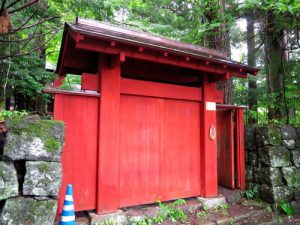
Beautiful red gate of villa, Nikko
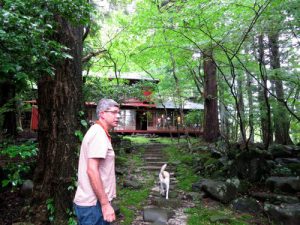
Hayden san and Mick
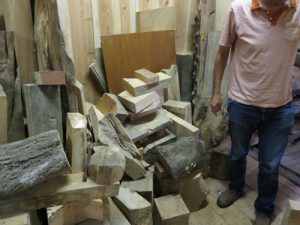
At the workshop
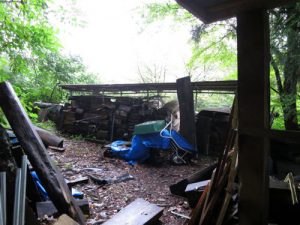
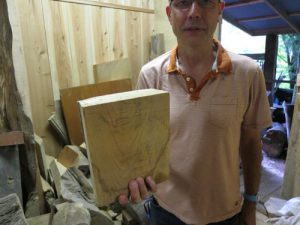
Cut into a small wood block
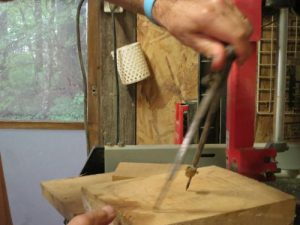
Measure the size and draw a line
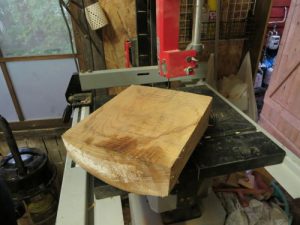
Cut along the line
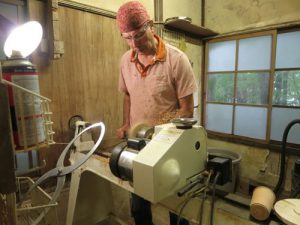
Using wood turning machine
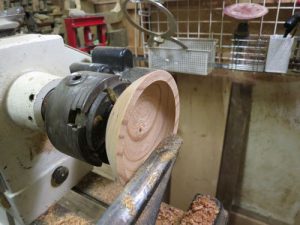
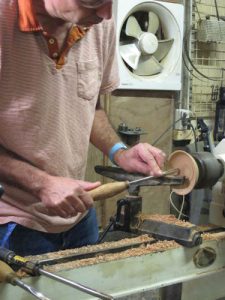
Turning wood on a lathe using a skew and gouge tool

Several tools for wood turning
Ian Hayden Profile
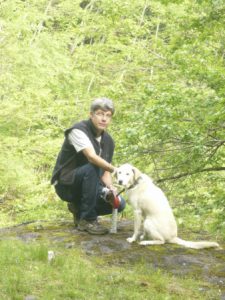
Graduated in Geology at London University, 1982
Studied on a post-graduate research scholarship at Kyushu University, 1986
Started woodturning, 2010
Participating Mashiko Pottery Fair and holding exhibition in Kanuma and Takasaki.
Made special plate for the Nikko Toshogu (UNESCO World Heritage designated Temple and Shrines) 400th Year Shikinen Grand Festival, 2015